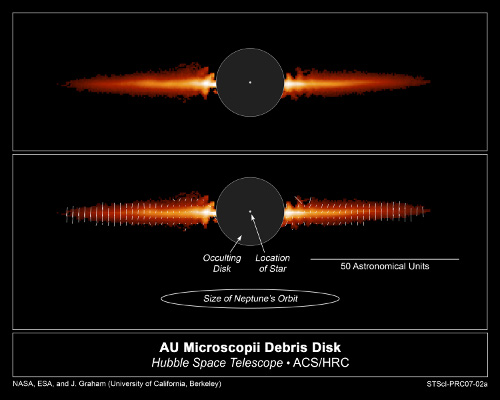Centauri Dreams
Imagining and Planning Interstellar Exploration
Future Splashdown in Ligeia Mare?
Given the budgetary situation, it’s nice to know we can still get to the outer Solar System without the cost of a flagship-class mission like Cassini, which weighed in at 3.26 billion — that included $1.4 billion for pre-launch development, $704 million for mission operations, $54 million for tracking and $422 million for the launch vehicle. Now Johns Hopkins Applied Physics Laboratory (JHU/APL) is moving forward on a much cheaper mission concept to reach Titan, one of the three proposals selected as candidates for an upcoming NASA Discovery Program mission.
We’re now down to three proposals for this mission out of an original 28 submitted last summer, with each team receiving $3 million to develop a still more detailed concept study. The Titan mission is just what the doctor ordered to perk up your ailing sense of wonder, intended to deliver a capsule called Titan Mare Explorer (TiME) that would land in and explore one of the large seas that Cassini has helped us map. The concept is clearly workable, and it will be cost-capped at $425 million, although this doesn’t cover the funding for the launch vehicle.
Remember that the NEAR mission, the first to orbit and land on an asteroid, was a JHU/APL creation — this was the first of the Discovery-class missions — and so is MESSENGER, now in orbit around Mercury since March. I’ve mentioned many times in these pages my interest in the Innovative Interstellar Explorer concept that has been developed there over the years in the hands of Ralph McNutt, with original work done through Phase I and II grants from NASA’s Institute for Advanced Concepts. And I certainly don’t want to forget the ongoing flight of New Horizons, designed and built at JHU/APL and tallying mission costs in the range of $700 million.
But I don’t want to focus solely on money here, because the Titan Mare Explorer, if chosen for flight, is the sort of breathtaking mission we’ve been hoping to see delivered to Titan, a robotic boat that would be parachuted into Ligeia Mare, the second largest of Titan’s northern seas, for a 96-day mission, measuring the moon’s organic molecules and analyzing its chemistry, not to mention producing images of sea and sky on Titan that would surely be unforgetable. The plan is to launch between 2016 and 2018 to arrive before winter sets in at the moon’s north pole.
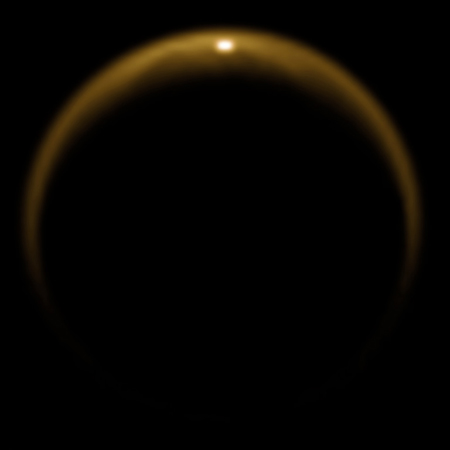
Image: Sunlight reflects off a Titan lake in this image captured by NASA’s Cassini spacecraft. The Titan Mare Explorer (TiME), a candidate for NASA’s next Discovery-class mission, would perform the first direct inspection of an ocean environment beyond Earth by landing in, and floating on, a large methane-ethane sea on the cloudy, complex moon of Saturn. Credit: NASA.
Here I want to quote TiME project lead scientist Ellen Stofan (Proxemy Research Gaithersburg, MD), who was recently interviewed by Ian O’Neill for Discovery News:
“Titan is often referred to as a pre-biotic world. It actually has all the sort of building block chemicals that were present on Earth when life evolved. The idea for Titan is that with those very, very cold temperatures and with water being frozen solid, could life actually develop, or is it just too cold so those chemical reactions just can’t get going?”
The two other Discovery Program possibilities are a mission to study the Martian interior (Geophysical Monitoring Station) and a cometary lander (Comet Hopper). We’ll have another review of all three studies in 2012, after which NASA will select the winner. In the meantime, it’s also interesting to see three proposals selected for technology development — this means selected teams will receive funding to bring their technologies to a higher readiness level. All three of these are interesting in their own right for long-term development:
- Whipple would use a technique called blind occultation to monitor tens of thousands of stars for signs of outer system objects, helping us inventory icy chunks at the system’s edge.
- NEOCam would study Near-Earth Objects through a new telescope designed for infrared measurements that help us understand small bodies crossing the Earth’s orbit.
- Primitive Material Explorer (PriME) would use a mass spectrometer to measure the chemical composition of a comet and explore the role of comets in delivering volatiles to Earth.

Habitability Around Nearby Stars
My friend Adam Crowl, a polymath if there ever was one, is working hard on Project Icarus and keeping an eye on the exoplanet situation. When you’re working on a starship design, no matter how theoretical, a major issue is the choice of targets, and the study of Kepler planets we looked at yesterday caught Adam’s eye some time ago. We’re not finding as many planets in the habitable zone thus far in the Kepler hunt as we might hope to, given that the ideal would be a habitable world somewhere within reach of near-future technologies of the kind that Icarus represents.
Sure, Kepler’s target stars are much further away in most cases, but the mission is giving us a useful statistical sampling from which we can generalize. Working with the data from Lisa Kaltenegger and Dimitri Sasselov’s paper, Adam thus takes a back-of-the-envelope stab at the galactic population of terrestrial worlds, knowing that Kepler is far from through, as we’re moving into the domain of planets with longer orbital periods. But if you had to go with what we have now, Adam estimates a population of ‘Earths’ somewhere in the range of 150 to 200 million in the Milky Way, assuming 100 billion stars for the galaxy, a figure that may be on the low side.
200 million habitable planets is a huge number even so, but if the total number goes down, so does the chance of finding one of these within, say, 100 light years of our Sun. We’re still shooting in the dark here, but we can only hope that the three ongoing searches of Centauri A and B will yield something interesting, or that we may find other exoplanet candidate stars hosting rocky worlds nearby. On that score, it’s intriguing to see that Gliese 581 d is back in the news, in the form of a new paper by Robin Wordsworth (Institut Pierre Simon Laplace, Paris) and colleagues.
Continuing Saga of a Nearby Red Dwarf
GJ 581 has been a major player in the exoplanet story since the 2007 announcement from the Geneva team of the potential habitability of GJ 581 c. Gliese 581 itself is an M-class red dwarf, smaller and cooler than our Sun, and a variety of studies have suggested that a habitable climate might be possible even on a world that, like GJ 581 c, is tidally locked to a star like this one, presenting the same face to the star throughout its orbit. Subsequent work, though, makes a strong case that GJ 581 c is more like Venus than anything else, while GJ 581 d, further out, may just make it inside the habitable zone, depending on conditions in its atmosphere.
Wordsworth and team are obviously aware of the discussion about the controversial detection of another planet, dubbed GJ 581 g, which appeared to be in the middle of the habitable zone. That one was announced in September of 2010, but its existence remains unconfirmed and in some cases strongly disputed. But GJ 581 d is a known quantity at least in some respects — it’s a ‘super-Earth’ with a minimum mass between 5.6 and 7.1 times that of Earth, and the question is whether a sufficiently dense atmosphere could give the planet a strong enough greenhouse effect for surface habitability, even though it receives 35 percent less energy from its star than does Mars.
The new paper uses global climate model simulations starting with the assumption that GJ 581 d’s climate is dominated by the greenhouse effects of CO2 and H2O, which is the case for the rocky planets with atmospheres in the Solar System. The model is put to work on a planet that may have a permanent night side, a place where volatiles like CO2 and H20 can freeze out on the surface. Even a relatively dense CO2 atmosphere can collapse under these conditions, so the simulations are designed to evaluate whether liquid water at the surface is possible.
The simulations used a global climate model developed specifically for exoplanet studies, assuming CO2 as the main atmospheric gas and drawing on these methods (from the paper):
To assess the influence of water on the climate independently, we considered two classes of initial condition: a rocky planet with no water, and an ocean planet, where the surface is treated as an infinite water source. CO2 was taken as the primary constituent of the atmosphere and H2O was allowed to vary freely, with surface ice / liquid and cloud formation (including radiative effects) taken into account for either gas when necessary. Restricting the composition of the atmosphere to two species in this way allows us to determine conservative conditions for habitability, as it neglects the warming due to other greenhouse gases like CH4 or buffer gases like N2 or Ar…
Greenhouse Warming and its Consequences
The researchers then performed simulations with 5, 10, 20 and 30 bar atmospheric pressure and varied the orbital resonances for both rocky and ocean planets. CO2 turns out to have a strong warming effect in these simulations, which showed that for pressures below about 10 bar, the atmosphere was unstable and began to condense on the poles and dark side of the planet. But denser atmospheres allowed enough heat transport and greenhouse warming to bring temperatures at the surface above the melting point of water, even as CO2 ice clouds frequently formed in the middle atmosphere, similar to the ice clouds we see on Mars.
So is it likely that CO2 partial pressures over 10 bar occur on GJ 581 d? We know nothing about the geophysics of this world, but if a mechanism exists there like the carbonate-silicate cycle we see on Earth, the atmospheric CO2 should stabilize at levels that allow oceans to exist. And of course there are other scenarios, as the authors point out: The planet could have a thick envelope of hydrogen and helium, like the atmospheres of Uranus and Neptune, or it could have no atmosphere at all — remember, GJ 581 is a red dwarf, a star whose frequent flare activity in its youth could have removed the early atmosphere. At this point, we just don’t know.
But the beauty of GJ 581 is that at 20 light years, it’s relatively near to the Earth, unlike most of the stars Kepler is now studying. That means that in the future, we’ll be able to discover which atmospheric scenario applies here by direct spectroscopic observations. The paper goes through the indicators that would help us distinguish between these scenarios, and it’s clear that this is a call we’ll one day be able to make as the technology comes online.
Thus the title of the paper by Wordsworth et al., “Gliese 581d is the first discovered terrestrial-mass exoplanet in the habitable zone,” accepted at Astrophysical Journal Letters (preprint). The caveat is obvious: The fact that a planet is in the habitable zone in some scenarios does not mean that it is actually habitable, but the new paper does tell us that this is a world that merits intense scrutiny, because oceans here are not beyond the realm of plausibility. If that’s the case, Project Icarus may be able to find at least one astrobiologically interesting planet within range of its vehicle after all.

Habitable Zone Planets and Kepler
A habitable zone can be defined in many ways, but for our immediate purposes, defining it with reference to liquid water on a planetary surface makes sense. Sure, we believe that life could exist beneath the surface on places like Europa, where surface water is out of the question, but the key issue is this: Are there atmospheric features that we could use to make the call on habitability? It’s an important issue because with our current and near-future technology, this is how we can plan to investigate life on planets around other stars. We can study exoplanetary atmospheres already and we’re getting better, but we can’t drill through exoplanetary ice.
A new paper from Lisa Kaltenegger and Dimitri Sasselov (Harvard Smithsonian Center for Astrophysics) gets into these questions by looking at how to evaluate habitability, studying different kinds of planetary atmospheres and developing model calculations. The intent is to apply these ideas to the habitable planet candidates, 54 in number, so far produced by the Kepler mission, but the work generalizes to planetary candidates from any transit searches. The smallest size objects in the current Kepler sample are clearly the most interesting, because they could have the kind of atmospheres we see from Venus through the Earth to Mars in our own system, a range of chemistries that points out the limits of this kind of habitable zone.
A habitable zone can be conceived as a ring — an annulus — around a star, and the key points are these:
… the inner edge of the HZ is defined as the location where the entire water reservoir can be vaporized by runaway greenhouse conditions, followed by the photo-dissociation of water vapor and subsequent escape of free hydrogen into space. The outer boundary is defined as the distance from the star where the maximum greenhouse effect fails to keep CO2 from condensing permanently, leading to runaway glaciation.
Not all planets in a habitable zone will be habitable, of course, but we can say many things about the potential for habitability. The width and distance of a habitable zone around a particular star depend on a number of parameters that we can hope to examine from Earth or space-based missions as our technology improves:
- Incident stellar flux. Here we’re looking at the luminosity of the host star, its spectral energy distribution, and the eccentricity of the planetary orbit.
- Planetary albedo, the reflecting power of the planetary surface.
- The concentration of greenhouse gases in the planet’s atmosphere.
- The energy distribution in the planet’s atmosphere.
The authors look at three models of Earth like planets, from planets with high concentrations of carbon dioxide in their atmospheres to those with atmospheres more or less like the Earth today and those with high values of water vapor, modeling these for stars with effective temperatures between 3700 K and 7200 K. The models thus represent planets on the outer edge of a habitable zone, in the middle of it, and on the inner edge. Examined in this way through a straightforward equation developed by the authors to measure potential habitability, many of the 54 planetary candidates thought to be in the habitable zone in the Kepler sample turn out to be outside of it because their temperatures are too high. 27 of the Kepler candidates show temperatures in the habitable range, three of them being candidates with radii smaller than two Earth radii.
Cloud cover is an intriguing variable. In fact, the authors point out that depending on cloud cover, the outer edge of the habitable zone in our own Solar System varies from 1.67 AU (cloud-free) to 1.95 AU and 2.4 AU (50% and 100% cloud cover respectively). Assuming cloud cover of 0%, 50% and 100%, we get three sets of results:
Applying our analysis to the whole Kepler planetary sample of 1235 transiting planetary candidates, assuming the maximum Earth-like Bond albedo for rocky planet atmospheres… results in 12, 27, 67 planetary candidates with Teq [equilibrium temperature] smaller than the water loss limit (Tsurf = 373K) for 0%, 50% and 100% clouds respectively, and 18, 43, 76 planetary candidates with temperatures lower than the runaway greenhouse limit respectively. Among those are 2, 3, 6 as well as 3, 4, 6 planets respectively, that have radii below 2 Earth radii consistent with rocky planets (KOI1026.01, 854.01, 701.03, 268.01, 326.01, 70.03).
We can use transit timing variations to calculate the density of rocky planet candidates occurring in multiple planet systems, but remember that the fact that a planet is rocky does not necessarily make it habitable, depending on the local abundance of water and other materials. That means a good terrestrial planet candidate has to have its atmosphere fully examined for signs of life, and here Kepler will not be enough. Its target stars are 500 to 1000 parsecs from us, making its findings extremely helpful statistically but less useful than a future targeted mission at finding small planets orbiting stars closer to the Sun whose atmospheres we can analyze.
The paper is Kaltenegger and Sasselov, “Exploring the Habitable Zone for Kepler planetary candidates,” submitted to Astrophysical Journal Letters (preprint).

The Pros and Cons of METI
Tau Zero journalist Larry Klaes has been fascinated by SETI — and its offshoot METI (Messaging to Extraterrestrial Intelligence) — for a long time now. Here he steps back to look at METI in context, offering up an examination of the advantages of sending signals to the stars and the offsetting risks. We’ve looked at many viewpoints on the subject in these pages since Centauri Dreams came online in 2004. But has Larry hit upon a key fact that may trump the arguments of both sides? Is there something about human nature that makes METI more or less inevitable?
By Larry Klaes
SETI, or the Search for Extraterrestrial Intelligence, has been conducted by a variety of professional and amateur scientists since 1960 (or 1924 if you want to count a campaign that year which listened for any radio messages from the presumed natives of Mars). SETI primarily involves the passive listening or looking for transmissions from alien civilizations. More recent SETI projects have also attempted to detect the massive technological activities of really advanced societies in our galaxy and beyond or any probes that might be lurking in our Solar System quietly monitoring humanity.
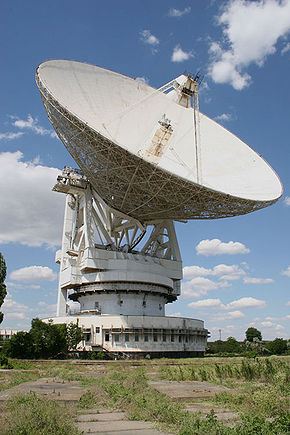
Our present level of space technology does not allow us to directly explore even the nearest star systems. As for the numerous if often sporadic SETI programs that have been operating around and even beyond our globe for the last fifty years, they rely heavily on either an alien society deliberately signaling us or our own luck in picking up a stray transmission from one of them. Throwing in the fact that our Milky Way galaxy holds hundreds of billions of star systems has some scientists advocating a less passive approach to learning if Earth is the only planet with intelligent life or not in the Cosmos.
Image: The Evpatoria RT-70 radio telescope and planetary radar at the Center for Deep Space Communications in Ukraine. Credit: S Korotkiy.
Dubbed METI, for Messaging to Extraterrestrial Intelligences, this concept involves transmitting our own messages and beacons into the galaxy to alert alien societies to humanity’s presence to make it easier for them to find us and respond in kind. As might be imagined, there has been plenty of debate over whether METI is the right way for humanity to find alien intelligences or if it will only make a malevolent species aware of Earth as a target of conquest and destruction.
In order to make some determination whether METI is humanity’s path to becoming a productive and progressive part of the galactic community or the route to our doom, let us look at the pros and cons of what also goes by the name of Active SETI.
The Nature of the Universe
The Milky Way is a huge spiral galaxy containing 400 billion star systems spread across 100,000 light years, with most stellar residents of this cosmic island averaging several light years apart. To give the reader an idea just how vast the Milky Way is, if our entire galaxy were shrunk down in scale to where a person could hold the entire Sol system in the palm of their hand, the Milky Way would still be the size of the North American continent.
In addition to the great number of stars and the incredible distances between them, SETI researchers also have to contend with the natural cosmic radio background which drowns out all but the strongest of artificial signals. Interstellar dust, which weaves its way throughout our galaxy, also blocks out many electromagnetic signals and whole regions of the Milky Way from our view.
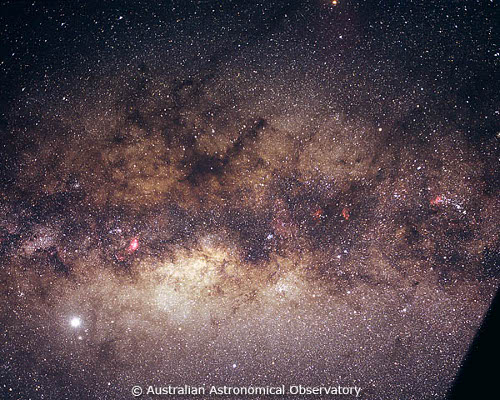
Image: The galactic centre itself is totally hidden at visible wavelengths by the band of dust which divides the Milky Way along much of its length. The dust lane is only visible because it blots out background stars. Embedded in the dust are many star-forming regions, seen as bright red emission nebulae. Credit: Anglo-Australian Observatory.
Humanity also has no real interstellar capabilities at present. The few deep space probes that have been sent on courses outside our Sol system would take 77,000 years to travel the distance to Earth’s nearest stellar neighbors, the Alpha Centauri star system.
None of the currently active robotic explorers will function more than a mere fraction of that time before expiring. Now it is true that our civilization has been producing a “bubble” of electromagnetic signals for over one century which has formed a 200 light year wide sphere of artificial signals in the galaxy, with Earth at its center. However, most of these transmissions were only meant for residents of our planet and thus were most often unintentionally aimed but briefly at random areas of the sky. They also tend to be rather weak signals, requiring a very large and sophisticated receiver to detect them even just a few light years from Earth. In short, humanity is hardly a standout in the grander cosmic scheme of things.
Why METI Will Benefit Humanity
To combat these odds to make SETI a success, humanity needs to start broadcasting our presence into space, deliberately targeting particular systems and other places in the Milky Way we think may be good places for finding our celestial neighbors. The transmissions could be as simple as a signal that clearly distinguishes itself to be artificial or a detailed introduction about ourselves and our world. Another suggestion is to have interstellar beacons continuously broadcast across the heavens for long periods of time to cover as much of the sky as possible, since we do not exactly know where alien societies may exist or how often they may be conducting their own SETI programs.

Any extraterrestrial intelligences which can find us by our METI programs and respond will likely be more advanced than humanity. This means these ETI will know more and be able to undertake activities which our species cannot do at present. We may therefore learn new things across many disciplines and improve ourselves both socially and technologically. Alien civilizations may also benefit in turn from information we share with them.
Image: Aleksandr Leonidovich Zaitsev, METI advocate and radio astronomer, whose messages to the cosmos include the 1999 and 2003 ‘Cosmic Calls’ from Evpatoria. Credit: Wikimedia Commons.
In regards to concerns about alerting to our presence any species that may want to harm humanity, Carl Sagan once postulated that hostile societies will probably either destroy or degenerate themselves before they can ever achieve interstellar flight. This would mean that any ETI who can detect and contact us would be benevolent or at least impartial, with the extra security of being very far away.
Even if some ETI are a threat to our existence and can also move between the suns, we may learn of this danger through the evidence of their own activities and transmissions or from other ETI who know of the threat they pose and are warning those societies they are aware of to beware of this or any other galactic danger. Being forewarned, we may have a chance to defend ourselves or perhaps form an escape plan working with our newfound allies to combat the immediate threat and form a mutual relationship between our worlds later on.
Interstellar travel, especially the kind which can achieve relativistic speeds, may be even more difficult than we currently realize. Certainly it is not obvious from Earth that large numbers of great starships are zipping about the galaxy on a regular basis. At the least this should give us some protection thanks to the incredible distances between star systems. METI would be the way that the sophisticated cultures of the Milky Way communicate, learn about, explore, and trade with each other, all from the relative safety of their home worlds.
Why METI May Doom Humanity
The biggest negative for METI is one that even members of the general public who do not study this subject are aware of through the popular media: Alerting an advanced alien intelligence to our presence in the galaxy could cause them to interact with us in ways that might harm or destroy our society and our species.
Historians and others cite the many examples in human history where the encounter between two different cultures with disparate technological levels often led to either the reduction or destruction of the less sophisticated society, even if the losers outnumbered the superior culture in population size.

Even if the historical encounter had not been one involving conquest or extermination, other factors often contributed to the demise of the native population. As just one example, unfamiliar diseases introduced into the native populations have killed more people than outright warfare in many cases. Missionary ventures and casual introductions have altered target societies so that if they do not disappear altogether, they become assimilated into the dominant culture until their bear little resemblance to their original selves.
Image: Science fiction author David Brin, one of METI’s most persistent critics. His 1983 paper “The Great Silence” offered an early look at the Fermi paradox and its implications for SETI. Credit: Contrary Brin.
All these scenarios and more have been suggested and feared in regards to making the galaxy take notice of humanity. Claims that any ETI who possess sufficient astronomical instruments may already know of Earth and its occupants through our electromagnetic leakage and even biological signatures have been countered by evidence that most of our radio and television signals are too weak on an interstellar scale to be detected by all but the most powerful devices. Even military and planetary radar beams, which are much stronger signals, are not aimed at specific points in space beyond our Sol system, reducing their chances of being noticed by ETI.
While we fret over a potentially dangerous response from the Universe, there is also the possibility that our METI efforts might cause similar harm to alien intelligences that may not be ready to deal with what we might have to say or even that we exist at all. We hope that an ETI will recognize that we are a relatively young society still struggling with our own issues and will leave us alone until we mature enough to properly interact with other galactic residents. However, there is also the possibility that an alien mind may not recognize us as developing and naive and could just as easily either take advantage of our weaknesses or complicate our lives by attempting to “help” us.
The Futility of Fighting Human Nature
One thing is certain, something that has already been happening for a while now: Though it may be prudent to think twice before sending any kind of information about ourselves into the Milky Way, there will always be those who defy the rules even if it is just for the sake of committing the act for itself.
There are now five deep space probes (and their last rocket stages) heading out of our Sol system into the wider galaxy. Four of these automatic vessels have suitable information packages aboard, while the newest member of this exclusive club, New Horizons, is carrying less sophisticated offerings to the Universe, with the exception of some of the ashes of Clyde Tombaugh, the man who discovered Pluto in 1930, the dwarf planet that New Horizons is on its way to briefly explore in 2015. The engraved plaques and golden records aboard the twin Pioneer and Voyager probes, respectively, were constructed and placed there largely by people outside the space institutions which made the probes possible, making up for a lack of foresight by the vessels’ creators. The New Horizons team eschewed any such project altogether, treating items for the probe like they were storing them into a small town’s time capsule.
As for METI in the radio realm, deliberate messages have been sent into the galaxy starting in 1962 with a brief Morse code transmission by the Soviet Union and then in 1974 with the more famous Arecibo Message to the globular star cluster Messier 13. There have been a number of other such METI efforts since then. A fair number, such as a series of transmissions from the Evpatoria facility in the Crimea, are serious, but others have been largely publicity stunts, such as hawking science fiction films and snacks. Most of those involved in these projects have not shown any great concern for the potential consequences of revealing ourselves to the Cosmos. This attitude is even stronger when it comes to the electromagnetic leakage our civilization has been producing for over one century now, celestially weak as most of it is.
A number of individuals and groups feel they have been underrepresented or not represented at all by the messages and offerings from past METI efforts, so they have sent their own broadcasts into the galaxy despite protests by others. Aleksandr Zaitsev is among the better known of these individuals who has utilized his position as chief scientist at the Russian Academy of Science’s Institute of Radio Engineering and Electronics to send detailed transmissions to a number of nearby star systems using the Evpatoria radio telescope. Zaitsev continues to perform and advocate these METI despite protests by others in various fields. Zaitsev counters that this is just what humanity needs to do if it ever wants to survive and mature as a species.
The fact is that while we must be careful how and if we should represent ourselves to the vast unknown that is the rest of the Universe, there will always be those people who defy the rules and regulations, be it out of a sense of duty to all humanity or just for the sake of rebellion against society. The next question is, do at least some other minds in the galaxy also think and act this way? Is just such a transmission on its way to Earth? What will be the consequences then? Will it make us finally grow up as a species, or will there be panic and doom? I welcome your thoughts on this important matter.

Key Effects of General Relativity Confirmed
Gravity Probe B has confirmed two of the most interesting effects predicted by Einstein’s General Theory of Relativity. The geodetic effect, which describes the warping of spacetime due to the mass of the Earth, has been confirmed to an accuracy of 0.28 percent. The frame-dragging effect, in which the Earth’s rotation drags or stirs local spacetime, is confirmed to 19 percent accuracy. All of this from a project that drew on 34 years of research and development, 10 years of flight preparation and 5 years of analysis of the data returned from a 1.5 year mission. They were a long time coming, but these results are as much milestones in the history of physics as the 1919 measurements of Sir Arthur Eddington that supported Einstein’s newly published theory.
Subtle Effects, Fantastic Precision
Measuring known effects to higher levels of accuracy is key to physics. It has taken so long to achieve these results because General Relativity is hard to test in the vicinity of the Earth, where its effects are so slight as to fade into the background noise. Gravity Probe B (GP-B) was built to surmount this problem by performing its experiments in an orbiting laboratory where the background noise could be effectively muted. At the heart of the effort were four gyroscopes held in a flight probe that was inserted into a dewar — a vacuum flask — that held 613 gallons of superfluid, supercold helium, keeping the instrument chilled to 2 Kelvin (-271 degrees Celsius).
Launched into a 645-kilometer orbit, Gravity Probe B’s science instrument measured the changes in the directions of spin of the gyroscopes, using a telescope referencing the star IM Pegasi as a fixed measuring point. The gyros were so free of background disturbances that they constituted an ideal measuring system. According to General Relativity, the direction of the spin axis of the gyroscopes should change over time because of the mass and rotation of the Earth, and these effects are what has been confirmed, showing that spacetime is indeed warped by the presence of the Earth, and twisted or dragged by the rotation of the Earth as well.
Kip Thorne (Caltech) once noted how subtle the effects under study by Gravity Probe B really are: “In the realm of black holes and the universe, the language of general relativity is spoken, and it is spoken loudly. But in our tiny solar system, the effects of general relativity are but whispers.” Hearing those whispers allows us to take earlier confirmations of General Relativity to a new level of precision, providing a measurement of the shape of local spacetime.
Envisioning Warped Spacetime
The geodetic warping of spacetime is usually explained through the image of a sheet of rubber on which a ball has been dropped, thus deforming the rubber. But I prefer the ‘missing inch’ explanation. It’s a bit of a thought experiment, though it can be replicated with a sheet of paper and a pair of scissors. Imagine a circle with the same circumference as the Earth, about 40,000 kilometers. A gyroscope that follows this path in empty space should always point in the same direction, as the diagram below illustrates. But General Relativity says that if the Earth were placed inside the circle, its mass would warp spacetime just enough to shrink the circumference of the circle by 1.1 inches.
Cut a small wedge out of a circular piece of paper and then tape the edges back together. The result is not a circle but a cone, a representation of what happens to spacetime as the result of mass (Thorne did a demonstration of this at the Gravity Probe B pre-launch news conference, video of which is available here). The gyroscope following this slightly altered path now shows a measurable shift as it moves around the edge of the cone, as shown in the second panel of the diagram.
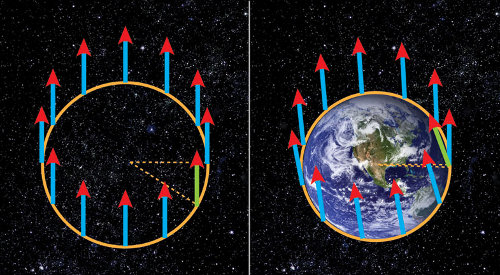
Image: Left panel: A circle with Earth’s equatorial diameter (~12,755 km) in empty space has a circumference of roughly 40,074 km. A gyroscope following this circular path in empty space will always point in the same direction, as indicated by the arrows. Right panel: Earth’s mass warps spacetime inside the circle into a cone, formed by removing a pie-shaped wedge (dotted lines). This reduces the circle’s circumference by 1.1 inches. A gyroscope will now change its orientation while tracing the conical path. Credit: Stanford University/NASA.
Frame dragging, the other effect measured by Gravity Probe B, refers to the way a rotating body drags spacetime around with it. Because of the parallel between this effect and the way an electrically charged body generates magnetism as it rotates, the frame dragging effect is often called the ‘gravitomagnetic effect.’ Gravity Probe B’s researchers measured the spin-axis alignment of each of its gyroscopes as the spacecraft orbited the Earth, looking at change both in the plane of the orbit (this measured geodetic precession) and orthogonally in the plane of the Earth’s rotation (this measured frame-dragging precession). You can read more about Gravity Probe B’s design and how it made these measurements at this Stanford website.
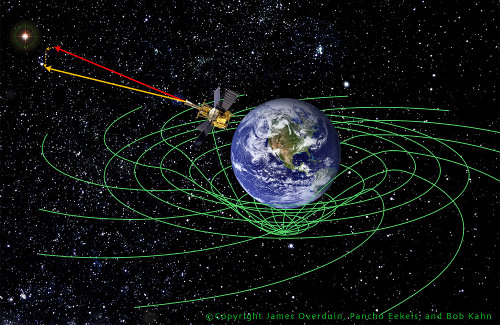
Image: Frame dragging as measured by Gravity Probe B. Credit and copyright: James Overduin, Pancho Eekels, Bob Kahn.
We’ve already had measurements of the geodetic effect, although GP-B has been able to refine that measurement considerably, but the new work on frame-dragging marks the first time it has been measured directly. Having confirmed that frame-dragging exists, the plan is to use these measurements to extrapolate what we’ve found around the Earth to more exotic objects, like black holes. “Einstein survives,” said Francis Everitt, who led the Gravity Probe B effort, and that survival should help us tighten our understanding of extreme astrophysical environments. Moreover, it will help us work toward a still more comprehensive theory. After all, the breakdown of General Relativity in singularities, where the curvature of spacetime becomes infinite and the field equations fail, points to how much we have yet to learn about the cosmos.

Terrestrial Planets: Find the Debris Disk
Over 900 stars have been found that show signs of a debris disk, a circumstellar disk of dust and debris orbiting the star. It takes less than 10 million years for the gaseous content of these disks to dissipate, leaving the dusty disk behind. You can think of the Kuiper Belt in our own system, but the analogy would be imprecise in a crucial way, for most of these disks show much more dust. In fact, explaining the difference between the debris disks of other stars and what we see in our own system is instructive, and it may offer clues to terrestrial planet formation elsewhere. For we’re learning that long-lasting cold dust points to a system-wide stability that is probably crucial.
At issue is the question of what happens when gas giants cause gravitational instabilities in a young system. Sean Raymond (Université de Bordeaux) and collaborators tackle the question in a new paper that looks at how planets emerge from circumstellar disks. Inner disks form rocky planets in 10 to 100 million years, the result of collisions between Moon-size or larger protoplanets and smaller planetesimals. Low in solid mass, the inner disk can’t produce rapidly forming giant planet cores — these emerge further out in the system, beyond the ‘snow line’ where temperatures are low enough that hydrogen compounds can condense into ice grains.
Image: HST-ACS image of the disk surrounding the nearby M dwarf, AU Mic. Credit: HST/Space Telescope Science Institute.
Now ponder this: Gas giants have to form quickly, within the first few million years after the appearance of the circumstellar disk of gas and dust, so they can pull in gaseous materials while these are still plentifully available. What that means is that the gas giants are present in a newly formed system while inner terrestrial planets are still growing. Raymond’s work uses simulations to look at how planetary systems around Sun-like stars evolve, studying how interactions between the giant planets and the gas disk itself affect rocky world formation.
It’s true that we’ve found numerous ‘hot Jupiters’ in star-hugging orbits, but the vast majority of giant planets are found beyond 1 AU — I won’t go into all the references here, but they’re found in Raymond’s paper, which also notes that changes as the gas disk dissipates can be a trigger to instabilities that lead to the ejection of one or more planets from the system. The simulations model the various interactions at work in a young planetary system, based on a scenario with 1) an inner disk of planetesimals and planetary embryos, 2) three gas giants at Jupiter/Saturn distances, and 3) an outer disk of planetesimals comparable to our own Kuiper Belt.
The results are striking, chief among them being that strong giant planet instabilities destroy planets in the inner system when they occur late, and can even destroy the population of icy planetesimals at the edge of the system. In about 40 percent of the unstable simulations, all rocky material was removed from the system, primarily being thrown into the host star. One in five of the simulations produced a system housing a single terrestrial planet. And gas giants in eccentric orbits deplete outer system disks by eventually ejecting their planetesimals altogether.
All of this has obvious implications for terrestrial planet hunters:
Debris disks correlate with a high efficiency of terrestrial planet formation. Strong scattering events yield large giant planet eccentricities, and these eccentric giant planets tend to disturb both the inner and outer planetary system. Thus, in a strongly perturbed system the giant planets tend to destroy both terrestrial planetary embryos – aborting the growth of terrestrial planets – and outer planetesimals – preventing the creation of debris disks by long-term collisional evolution. In contrast, in a calm system the giant planets will not strongly impede on the inner or outer planetary system, allowing for the formation of terrestrial planets and long-lasting cold dust. The debris disk-terrestrial planet correlation holds for all wavelengths we tested… The correlation also holds for all times later than about 10-30 Myr… and probably even earlier.
If we’re looking for terrestrial planets, systems with bright debris disks therefore move to the top of our list. These disks are the marker for relatively stable systems, where planets can accrete in the inner regions while significant dust can be produced in the outer zones, detectable at mid-infrared wavelengths. A star older than approximately 100 million years with bright emission of cold dust points to a stable environment that allows terrestrial planet formation. The paper adds that emissions like these are found around 16 percent of billion-year old Sol-type stars.
But back to the Kuiper Belt, and why our own system appears a bit unusual in this context. What we see around our Sun includes multiple terrestrial (rocky) planets, gas giants in low eccentricity orbits and relatively low dust content. The thinking is that the early system was relatively stable but later underwent a strong destabilizing event large enough to remove most of the outer planetesimal disk but not large enough to destabilize the inner system. That event was most likely the cause of the Late Heavy Bombardment, a period between 4.1 and 3.8 billion years ago when asteroid and cometary materials caused numerous impacts in the inner system. This may have been the result of giant planet migration, but whatever the instability was that caused the effect, it was weaker than could be modeled by Raymond’s simulations.
The paper is Raymond et al., “Debris disks as signposts of terrestrial planet formation,” in press at Astronomy & Astrophysics (preprint). Thanks to Andy Tribick for the pointer to this one.

